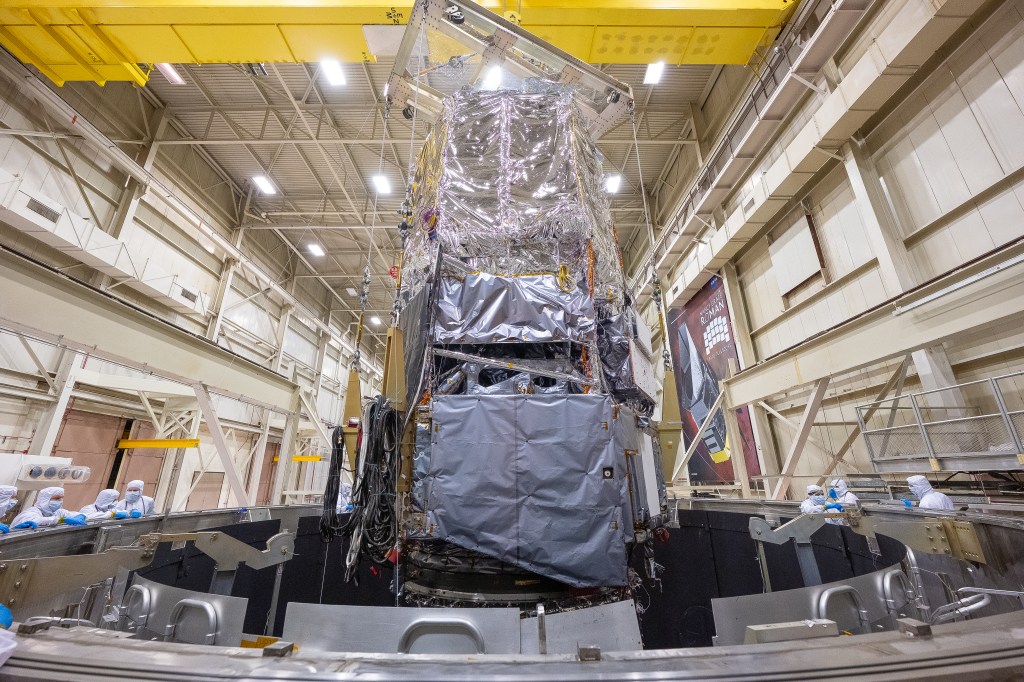1 min read
Omega Centauri (cropped)

An international team of astronomers has used more than 500 images from NASA's Hubble Space Telescope – spanning two decades of observations – to detect seven fast-moving stars in the innermost region of Omega Centauri, the largest and brightest globular cluster in the sky. These stars provide compelling new evidence for the presence of an intermediate-mass black hole (IMBH).
Omega Centauri is visible from Earth with the naked eye and is one of the favorite celestial objects for stargazers in the southern hemisphere. Although the cluster is 17,700 light-years away, lying just above the plane of the Milky Way, it appears almost as large as the full Moon when seen from a dark rural area. The exact classification of Omega Centauri has evolved through time, as our ability to study it has improved. It was first listed in Ptolemy's catalog nearly 2,000 years ago as a single star. Edmond Halley reported it as a nebula in 1677. In the 1830s the English astronomer John Herschel was the first to recognize it as a globular cluster. Omega Centauri consists of roughly 10 million stars that are gravitationally bound. The cluster is about 10 times as massive as other big globular clusters – almost as massive as a small galaxy.
This image shows the central region of the Omega Centauri globular cluster, where the IMBH candidate was found.
About the Object
- R.A. PositionR.A. PositionRight ascension – analogous to longitude – is one component of an object's position.13:26:49.56
- Dec. PositionDec. PositionDeclination – analogous to latitude – is one component of an object's position.-47:29:32.66
- ConstellationConstellationOne of 88 recognized regions of the celestial sphere in which the object appears.Centaurus
- DistanceDistanceThe physical distance from Earth to the astronomical object. Distances within our solar system are usually measured in Astronomical Units (AU). Distances between stars are usually measured in light-years. Interstellar distances can also be measured in parsecs.17,700 light-years
- DimensionsDimensionsThe physical size of the object or the apparent angle it subtends on the sky.Image is about 9.2 arcminutes across (47 light-years)
About the Data
- Data DescriptionData DescriptionProposal: A description of the observations, their scientific justification, and the links to the data available in the science archive.
Science Team: The astronomers who planned the observations and analyzed the data. "PI" refers to the Principal Investigator.The HST observations include those from programs 9442 (A. Cool), 10252 (J. Anderson), 10775, (A. Sarajedini), 12193 (J. Lee), 13066 (L. Smith), 13606 (J. Anderson), 15594(V. Kozhurina-Platais), 15764 (N. Hathi), 15857 (A. Bellini), 16380 (M. Chiaberge), 16384 (Y. Cohen), 16520 (N. Hathi), 16968 (N. Hathi), 11452 (J. Quijano), 11011 (C. Kochnek), 12094 (L. Petro), 12339 (E. Sabbi), 12353 (V. Kozhurina-Platais), 12580 (A. Renzini), 12694 (K. Long), 12700 (A. Riess), 12714 (V. Kozhurina-Platais), 12802 (J. MacKenty), 13100 (V. Kozhurina-Platais), 13570 (V. Kozhurina-Platais), 14031 (V. Kozhurina-Platais), 14393 (V. Kozhurina-Platais), 14550 (V. Kozhurina-Platais), 14759 (T. Brown), 15000(V. Kozhurina-Platais), 15593 (V. Kozhurina-Platais), 15594(V. Kozhurina-Platais), 15733 (V. Kozhurina-Platais), 15857 (A. Bellini), 16117 (M. Reinhart), 16514 (R. Bohlin), 16441 (J. Anderson), 16588 (V. Kozhurina-Platais), 16777 (A. Seth), and 17023 (C. Martlin).
This dataset contains HST observations of the globular cluster Omega Centauri out to its half-light radius. The data were selected to contain all available observations with filters suitable for high-precision astrometry (ACS/WFC: F435W, F475W, F555W, F606W, F625W, F775W, F814W; WFC3/UVIS: F336W, F390W, F438W, F555W, F606W, F775W, F814W). In addition, the filters ACS/WFC F658N and WFC3/UVIS F275W were added for photometric purposes as they also cover almost the entire half-light radius. The data were taken in the time spanning from June 2002 to March 2023. They have been collectively compiled here.
- InstrumentInstrumentThe science instrument used to produce the data.WFC3/UVIS, ACS/WFC
- Exposure DatesExposure DatesThe date(s) that the telescope made its observations and the total exposure time.27 June 2002- 23 Feb 2024
- FiltersFiltersThe camera filters that were used in the science observations.F275W, F336W, F438W, F606W, F625W, F658N, F814W
- Object NameObject NameA name or catalog number that astronomers use to identify an astronomical object.Omega Centauri, NGC 5139
- Object DescriptionObject DescriptionThe type of astronomical object.Globular cluster
- Release DateJuly 10, 2024
- Science ReleaseNASA’s Hubble Finds Strong Evidence for Intermediate-Mass Black Hole in Omega Centauri
- CreditESA/Hubble, NASA, Maximilian Häberle (MPIA)

These images are a composite of separate exposures acquired by the WFC3/UVIS instrument on the Hubble Space Telescope. Several filters were used to sample various wavelength ranges. The color results from assigning different hues (colors) to each monochromatic (grayscale) image associated with an individual filter. In this case, the assigned colors are: Blue= F275W + F336W + F438W, Green= F606W + F625W, Red= F658N + F814W
Related Images & Videos

IMBH Candidate in Omega Centauri
An international team of astronomers has used more than 500 images from NASA's Hubble Space Telescope – spanning two decades of observations – to detect seven fast-moving stars in the innermost region of Omega Centauri, the largest and brightest globular cluster in the sky....
Share
Details
Claire Andreoli
NASA’s Goddard Space Flight Center
Greenbelt, Maryland
claire.andreoli@nasa.gov




























